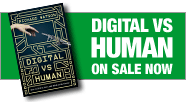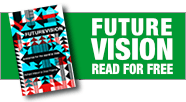Top Trends in Retail, shopping & leisure
1. Self serve
 Customer service costs money and is notoriously difficult to do well, so why not get customers to do it themselves? Everyone saves money and your customers think they’re in charge. Current examples include self check-in kiosks in airports, self-scanning machines in supermarkets and DIY check out services in hotels. Similarly, expect to see a boom in very intelligent vending machines very soon. If you prefer your service delivered by someone else, there’s even a car dealership in Japan that ‘employs’ robots as salesmen.
Customer service costs money and is notoriously difficult to do well, so why not get customers to do it themselves? Everyone saves money and your customers think they’re in charge. Current examples include self check-in kiosks in airports, self-scanning machines in supermarkets and DIY check out services in hotels. Similarly, expect to see a boom in very intelligent vending machines very soon. If you prefer your service delivered by someone else, there’s even a car dealership in Japan that ‘employs’ robots as salesmen. Read/post comments on this trend (currently 0 comments)
2. Cost polarisation
 By 2015 the middle class will have disappeared in most developed countries taking mid-price retailers with them. Hence most consumer markets are already polarising between economy and premium sectors (low price versus luxury). However, customers can happily live in both segments buying $15 T-shirts one minute and $500 jeans the next.
By 2015 the middle class will have disappeared in most developed countries taking mid-price retailers with them. Hence most consumer markets are already polarising between economy and premium sectors (low price versus luxury). However, customers can happily live in both segments buying $15 T-shirts one minute and $500 jeans the next. Read/post comments on this trend (currently 1 comment)
3. Blurring of sectors
 Bookshops selling coffee, coffee shops selling music, supermarkets selling loans, Ralph Lauren selling white paint and water companies selling gas. Just how far can you stretch a brand these days before it snaps?
Bookshops selling coffee, coffee shops selling music, supermarkets selling loans, Ralph Lauren selling white paint and water companies selling gas. Just how far can you stretch a brand these days before it snaps? Read/post comments on this trend (currently 0 comments)
4. High speed retail
 ‘24-hour banking, who’s got time for that?’ Like most good jokes this one, from US comedian Steve Wright, is close to the truth. People are leading increasingly hectic lives. Back in 1900 people slept for 9.0 hours every night. Now it’s just 6.9 hours. This is driving trends like drive-by dining, mobile banking and it’s also killing giant malls, which take too much time to shop. Equally, people are getting increasingly bored with the same brands in the same places, which in turn is driving ‘pop-up’ retail and ‘limited time only’ products and offers. Also links with the ‘Zara effect’.
‘24-hour banking, who’s got time for that?’ Like most good jokes this one, from US comedian Steve Wright, is close to the truth. People are leading increasingly hectic lives. Back in 1900 people slept for 9.0 hours every night. Now it’s just 6.9 hours. This is driving trends like drive-by dining, mobile banking and it’s also killing giant malls, which take too much time to shop. Equally, people are getting increasingly bored with the same brands in the same places, which in turn is driving ‘pop-up’ retail and ‘limited time only’ products and offers. Also links with the ‘Zara effect’. Read/post comments on this trend (currently 0 comments)
5. Brand experience
 A significant number of (lucky) people have got all the ‘stuff’ they need, so they are now, increasingly, looking for experiences not products. Research suggests that this is especially true for women. Examples include WHSmith (a UK stationer) selling cooking courses, hot air balloon lessons and Ferrari drive days. In theory this trend should benefit flagship retail, but the jury is still out on whether these temples of brand experience are really anything more than expensive poster sites.
A significant number of (lucky) people have got all the ‘stuff’ they need, so they are now, increasingly, looking for experiences not products. Research suggests that this is especially true for women. Examples include WHSmith (a UK stationer) selling cooking courses, hot air balloon lessons and Ferrari drive days. In theory this trend should benefit flagship retail, but the jury is still out on whether these temples of brand experience are really anything more than expensive poster sites. Read/post comments on this trend (currently 0 comments)
6. RFID
 Radio Frequency Identification Devices (RFIDs) are essentially glorified barcodes - tiny microchips with an antenna attached which retailers can use remotely to manage inventory and stop theft. They can also be used to trigger promotional messages when you pick up a product in store (like in the Prada store in New York). In the future RFID readers could scan your bags as you leave a store and automatically take the money from a suitably enabled mobile phone (or a tiny chip located in your forearm or teeth) which is linked to your bank or credit card. RFIDs have a myriad of other uses too, such as remote monitoring (healthcare) and baggage tracking (transport). In Japan a school even used RFID readers to tell parents that their children have arrived safely at school. Expect a major surge in RFID adoption in 2006+
Radio Frequency Identification Devices (RFIDs) are essentially glorified barcodes - tiny microchips with an antenna attached which retailers can use remotely to manage inventory and stop theft. They can also be used to trigger promotional messages when you pick up a product in store (like in the Prada store in New York). In the future RFID readers could scan your bags as you leave a store and automatically take the money from a suitably enabled mobile phone (or a tiny chip located in your forearm or teeth) which is linked to your bank or credit card. RFIDs have a myriad of other uses too, such as remote monitoring (healthcare) and baggage tracking (transport). In Japan a school even used RFID readers to tell parents that their children have arrived safely at school. Expect a major surge in RFID adoption in 2006+ Read/post comments on this trend (currently 0 comments)
7. Brand politics
 We’ve already got sweat-shop-free clothing brands, the return of neighbourhood retail and anti-supermarket sentiments, but we still haven’t seen anything yet. In the future customers will be interrogating brands online and scanning products in supermarkets with mobile phones to check on the ethical policy of brands (you can already do this in Japan). Ethically based retail concepts (think Body Shop or fair trade coffee) will grow in the future although customers’ willingness to pay high prices or suffer inconvenience will naturally limit growth in this area.
We’ve already got sweat-shop-free clothing brands, the return of neighbourhood retail and anti-supermarket sentiments, but we still haven’t seen anything yet. In the future customers will be interrogating brands online and scanning products in supermarkets with mobile phones to check on the ethical policy of brands (you can already do this in Japan). Ethically based retail concepts (think Body Shop or fair trade coffee) will grow in the future although customers’ willingness to pay high prices or suffer inconvenience will naturally limit growth in this area. Read/post comments on this trend (currently 0 comments)
8. Generational crossover
 It’s someone’s 50th birthday every 8 seconds in the US, but retailers are still obsessively focussed on young people. A study by Credit Suisse First Boston, for example, found that in the US there 7,700 clothing chains selling to the teen market (with a theoretical sales of US $5.8m per store) but only 1,800 (with theoretical sales of US $19.2m per store) targeting baby boomers. As populations age more people will want to spend more time at home and they will want to make their lives as comfortable as possible. The implications of this demographic shift include everything from a boom in gardening to employing seniors (B&Q) and designing food packaging that people with old hands and poor eyesight can actually open.
It’s someone’s 50th birthday every 8 seconds in the US, but retailers are still obsessively focussed on young people. A study by Credit Suisse First Boston, for example, found that in the US there 7,700 clothing chains selling to the teen market (with a theoretical sales of US $5.8m per store) but only 1,800 (with theoretical sales of US $19.2m per store) targeting baby boomers. As populations age more people will want to spend more time at home and they will want to make their lives as comfortable as possible. The implications of this demographic shift include everything from a boom in gardening to employing seniors (B&Q) and designing food packaging that people with old hands and poor eyesight can actually open. Read/post comments on this trend (currently 0 comments)
9. Women
 Women are the biggest market on earth but they are largely ignored - because most of the world is run by men. Nevertheless, we’ve already got women only floors in hotels, women only nightclubs, women only gyms and women only department stores. Given that women buy 65% of cars and make 81% of financial decisions, how long before we see women only garages and women only banks?
Women are the biggest market on earth but they are largely ignored - because most of the world is run by men. Nevertheless, we’ve already got women only floors in hotels, women only nightclubs, women only gyms and women only department stores. Given that women buy 65% of cars and make 81% of financial decisions, how long before we see women only garages and women only banks? Read/post comments on this trend (currently 0 comments)
10. Mass customisation
 As we have already noted, we are moving out of the era of mass and cheap into the age of luxury and ‘made for me’. For the fortunate few this means bespoke (tailor-made) products (sold in brand experience stores with concierge level service), while for others it means limited run products or mass customisation (products created for specific niches or groups, often with the help of the customers themselves). Mass customisation is a trend created by commodification, which has in turn been created by globalisation.
As we have already noted, we are moving out of the era of mass and cheap into the age of luxury and ‘made for me’. For the fortunate few this means bespoke (tailor-made) products (sold in brand experience stores with concierge level service), while for others it means limited run products or mass customisation (products created for specific niches or groups, often with the help of the customers themselves). Mass customisation is a trend created by commodification, which has in turn been created by globalisation. Read/post comments on this trend (currently 0 comments)


